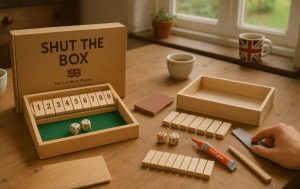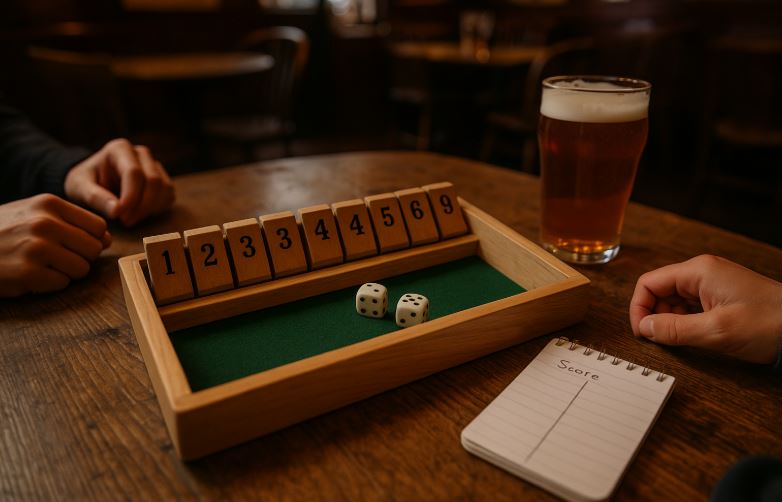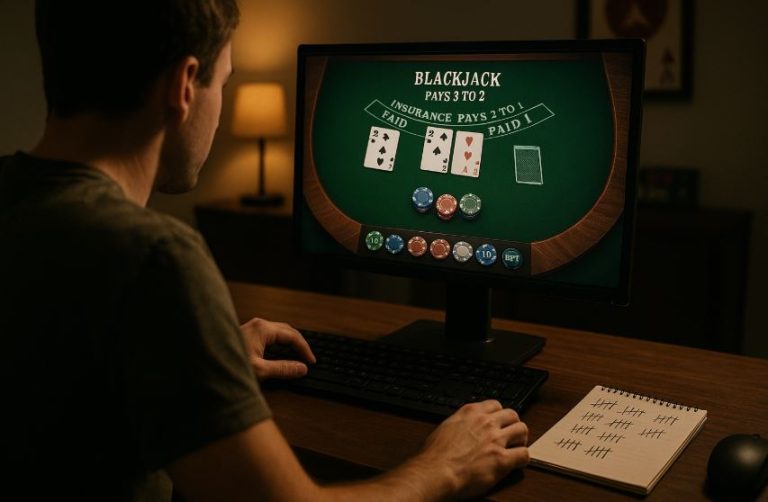Shut the Box Game | Complete Rules, Setup and Strategy!
When he first stumbled across a beautifully carved wooden box in a traditional British pub, he had no idea he was about to discover a timeless classic.
The shut the box game may seem old-fashioned, but it has captivated people for centuries, and for good reason.
Today, whether it’s found in a classroom, on a family table, or in a mobile app, Shut the Box remains a charming and challenging dice game that appeals to all ages.
In this blog, readers will learn everything about this engaging game, from its origins to rules, strategies, and even how to play online.
Whether someone is completely new or looking to sharpen their skills, this guide offers a comprehensive look at the Shut the Box game in 2025.
What is Shut the Box Game?

The Shut the Box game is a traditional dice-based game played with a wooden box, usually containing numbered tiles or flaps from 1 to 9. The primary objective is to flip down all the numbered tiles by rolling the dice and using arithmetic to match the sum of the dice to available numbers.
Gameplay Concept
Shut the box is typically played solo or in groups. Players take turns rolling two dice and “shutting” the numbered tiles that total the number rolled.
If a player cannot match the rolled number with any combination of remaining open tiles, their turn ends. The goal is to “shut the box”, meaning all numbers are flipped down.
Popularity and Accessibility
Over the years, this game has become a staple in pubs, schools, and households across the UK and beyond. With the rise of digital platforms, it has also found a new audience online. The appeal lies in its balance of luck and strategic decision-making.
Typical Player Setup
- One wooden shut the box tray
- Tiles numbered 1 to 9 (or up to 12 in variations)
- Two dice
- 1–4 players or more in turn-based mode
This game is easy to learn, requires minimal equipment, and offers quick rounds, making it a perfect pastime for both casual and competitive players.
What is the History Behind Shut the Box?
The Shut the Box game has a rich and debated history, with roots believed to trace back to 12th-century Normandy, France. It gained popularity throughout Europe, especially in England, where it evolved into a common pub game.
Evolution Across Cultures
While the exact origin is unclear, the game’s structure aligns with early arithmetic and counting games used for teaching.
In the UK, it became a pub favourite in the 20th century, often found in coastal and countryside taverns where patrons could challenge each other during social evenings.
From Pub Game to Global Pastime
By the early 2000s, the game had transformed from a local tavern treasure into a family-friendly classic and educational tool. Its growth continued with the emergence of digital adaptations and apps.
Milestones in Development
- Adopted in British pubs during the 19th century
- Used in classrooms for teaching addition and probability
- Commercially manufactured wooden sets from the mid-20th century
- Online versions introduced in the 2010s
- Gained popularity during the COVID-19 lockdowns for remote play
Despite its humble origins, Shut the Box continues to evolve, captivating new audiences every year.
What Equipment Do You Need to Play Shut the Box?
The game is minimalistic in its equipment needs, which contributes to its charm and accessibility.
Standard Physical Setup
- Wooden Game Box: Usually square or rectangular with hinged number tiles ranging from 1 to 9 or 1 to 12. The numbers flip or slide down when selected.
- Dice: Two standard six-sided dice are used. Some variations use only one die once tiles above 6 are shut.
- Scoring Pad (Optional): While not mandatory, players can use a notepad to record scores across rounds for tournament-style play.
Setup for Multiple Players
When playing with two or more players, the same board can be used with players taking turns. If a player shuts all numbers, they typically win that round instantly.
How to Play Shut the Box Game? – Step by Step Guide

Learning to play Shut the Box is straightforward, yet it offers a surprising amount of strategy. Whether you’re playing solo or with a group, the goal remains the same: to shut all the numbered tiles by matching them to the sum of your dice rolls. Let’s take a closer look at how the game unfolds.
Step 1: Set Up the Game
Begin by placing the shut the box game board on a flat surface. Make sure all number tiles (usually from 1 to 9 or 1 to 12) are flipped up and clearly visible.
Each player uses the same set during their turn, and the numbers are reset after every round. You’ll need two dice and the game board. Optionally, have a notepad or scorecard if you’re tracking points over several rounds.
Step 2: Roll the Dice
The first player rolls both dice. The sum of the two numbers rolled determines which numbered tiles can be flipped down. The goal is to find a valid combination of tiles that add up to the dice total.
Step 3: Flip Numbers Matching the Dice Total
The player must now choose one or more tiles that add up to the number rolled. For example, a roll of 8 could be matched by flipping the tile numbered 8, or combinations like 2 and 6, or 3 and 5. This decision requires strategy, as the remaining tiles affect future moves.
Step 4: Repeat Until No Moves Are Possible
As long as a player can make a move that matches the dice roll, they continue. Once no available tiles add up to the number rolled, the player’s turn ends. The total of the unflipped tiles is their score for that round.
Step 5: Next Player’s Turn
The next player resets the board by flipping all tiles back up and repeats the process. At the end of the round, the player with the lowest score wins. If a player flips all tiles and achieves a score of 0, it’s called a “shut the box” and they automatically win that round.
When to Use One Die?
When only the tiles numbered 6 or lower are left, house rules often allow the use of a single die to make it easier to score with smaller sums.
Optional Rule Variants
- Use two dice throughout the game
- Introduce a third die for added difficulty
- Customise scoring rules based on remaining numbers or add penalties for high totals
These flexible rules make Shut the Box adaptable for different skill levels and player preferences.
Shut the Box Game Rules Explained
Although the game has an old-world feel, its rules are modern in clarity. It suits players of all ages, thanks to its quick learning curve and addictive nature. Let’s break down the standard rules for better understanding.
Basic Rules
Players take turns rolling two dice. The sum of the numbers rolled must be matched by flipping down one or more numbered tiles. Only valid combinations may be used. For example, a roll of 9 can match tiles 9, 6, and 3, or 4 and 5, but not tiles already flipped.
If no combination is possible, the player’s turn ends. The remaining unflipped tiles are added up, and that total becomes their score.
Scoring
Scoring is straightforward. The sum of the tiles left standing determines the score. The goal is to achieve the lowest score possible. A perfect round with all tiles flipped earns a zero and an automatic win for that round.
In multiplayer games, scores can be tracked over several rounds to determine a winner. Alternatively, a match can consist of a set number of rounds with cumulative scoring.
Win Conditions
There are two ways to win:
- Get the lowest total score over a set of rounds
- Flip down all the numbers to score 0 and “shut the box”
Clear, simple, and elegant, these rules have helped make Shut the Box a game for generations.
What Are the Most Popular Variations of Shut the Box?

Variations are where the shut the box transforms from a simple pastime into a dynamic and versatile game. These tweaks add excitement and suit different ages or challenge levels.
Common Variants
Some versions use tiles numbered 1 to 12 instead of the traditional 1 to 9, which increases the range of possible moves and requires more strategic thinking.
Other versions add a third die to increase complexity and scoring potential. Elimination formats are also popular, where the player with the highest score is knocked out each round until only one remains.
These popular variants maintain the core mechanics but spice things up for experienced players.
Strategic Variants
- Custom scoring rules: Some variations award penalties based on squared or cubed remaining values.
- Team play: Partners alternate turns and collaborate on decisions.
- Time-limited turns: Add a timer to increase pace and pressure.
These adaptations keep the game fresh and allow it to scale from beginner to competitive level without losing its charm.
What Strategies Help Win the Shut the Box Game?
While chance plays a role, experienced players know strategy is essential for consistently low scores. Making smarter decisions can turn the tide in any match.
Prioritise High-Value Numbers Early
High numbers are harder to match as the game progresses and dice totals become smaller. By eliminating tiles like 9, 8, and 7 early on, players keep their options open for future rolls.
Use Flexible Combinations
Try to flip combinations that leave behind the most diverse numbers. For instance, flipping 2 and 4 might be better than 6 because 2 and 4 offer more pairing opportunities in later turns.
Know When to Switch to One Die
Once all numbers above 6 are flipped, switching to one die may improve your odds. Using two dice may lead to totals that are impossible to match with remaining tiles.
Minimise Remaining Tile Value
Always plan ahead to reduce your score. Even if you can’t shut the box, aim to leave the smallest possible numbers unflipped.
How to Play Shut the Box Game Online?

With the rise of digital gaming, Shut the Box has successfully made the leap from wood to web. Playing online offers convenience, accessibility, and sometimes a wider range of gameplay options.
Browser-Based Versions
There are several websites where you can play Shut the Box directly in your browser. These typically simulate the board, dice, and flipping tiles. They require no downloads and offer solo and multiplayer modes.
Mobile Apps
Apps for iOS and Android bring the game to your fingertips. Many feature tutorials, scoring systems, different rulesets, and online competitions. These are ideal for learning or practising on the go.
Online Multiplayer Modes
Most online versions allow real-time competition with friends or strangers. Some include chat functions, leaderboards, and win tracking, making the digital experience just as engaging as playing in person.
What Makes Shut the Box Ideal for Kids and Adults?
Few games balance educational value and entertainment as well as Shut the Box. It’s this blend that makes it popular in classrooms and game nights alike.
Educational Value for Children
The game enhances numeracy, as children constantly add, subtract, and calculate combinations. It strengthens problem-solving and introduces them to decision-making under uncertainty, all while remaining enjoyable.
Social and Mental Benefits for Adults
For adults, the game offers a blend of mental stimulation and social interaction. It promotes strategic thinking, keeps the brain active, and encourages friendly competition.
Portable and Easy to Set Up
The game requires little space and minimal equipment. It’s easy to carry, quick to set up, and suitable for almost any environment, from classrooms to picnics and family dinners.
This accessibility and cross-generational appeal are what make it truly special.
What Are Common Mistakes Players Make in Shut the Box?
Understanding the most frequent errors can dramatically improve gameplay. While shut the box may seem simple at first, the decisions players make can significantly affect their outcome.
Playing Without Strategy
Many beginners randomly flip tiles without considering future options. This lack of planning often leads to dead-ends and higher scores.
Ignoring Dice Probabilities
Not all dice totals are equally likely. For instance, 7 is the most common outcome when rolling two dice. Planning around the probabilities can increase your chances of making a valid move in the next turn.
Delaying Use of One Die
Waiting too long to switch from two dice to one when the high tiles are gone often leads to missed opportunities and wasted rolls.
Recognising and correcting these mistakes can lead to better decision-making and lower scores over time.
What is the Best Way to Buy or Make a Shut the Box Game in the UK?

Whether you’re buying a pre-made version or crafting your own, Shut the Box is easily accessible in the UK.
Buying Options
Many reputable retailers, both online and on the high street, stock high-quality versions of Shut the Box. From traditional wooden sets to colourful, child-friendly versions, there’s a wide range to choose from.
UK-based artisan shops even offer customised, handcrafted versions that make great gifts or collector’s items.
DIY Shut the Box
If you’re into crafts, building your own version is both rewarding and cost-effective. All you need is:
- A shallow wooden box or tray
- Numbered tiles, which can be made from wood or thick card
- Small hinges or sliding mechanisms for flipping
- A pair of standard dice
Creating a handmade set gives the game a personal touch and allows for customisation in size, colour, and numbering.
Conclusion
The shut the box game continues to thrive in 2025, enjoyed by families, educators, and pub-goers across the UK. Its unique blend of simplicity, mathematics, and strategy has made it a lasting favourite.
From its rich history to modern digital versions, the game remains both nostalgic and relevant. Whether someone plays casually at home, challenges friends online, or crafts their own set, the joy of shutting the box is timeless.
Frequently Asked Questions
How many players can play shut the box?
Shut the Box can be played solo or with multiple players taking turns. Typically, 1 to 4 players is ideal.
Is shut the box suitable for young children?
Yes, it’s excellent for teaching arithmetic, logic, and patience to children aged 6 and above.
Can shut the box be played competitively?
Yes, players can keep score across rounds, and tournament formats are common in clubs and pubs.
What’s the best way to score shut the box?
The score is the sum of the numbers left unflipped. The lowest score wins, and zero means a perfect shut.
Is there a standard size for shut the box boards?
Standard boards typically range from 8 to 12 inches wide but may vary depending on manufacturer.
Are there mobile apps for shut the box?
Yes, various apps are available with different features such as single player, multiplayer, and tutorials.
What materials are best for making a shut the box game?
Wood is preferred for durability and aesthetics. Plastic versions exist but lack the traditional feel.
Disclaimer
This information is shared for educational purposes only. We do not endorse gambling. Please make informed choices and gamble responsibly if you choose to participate.







